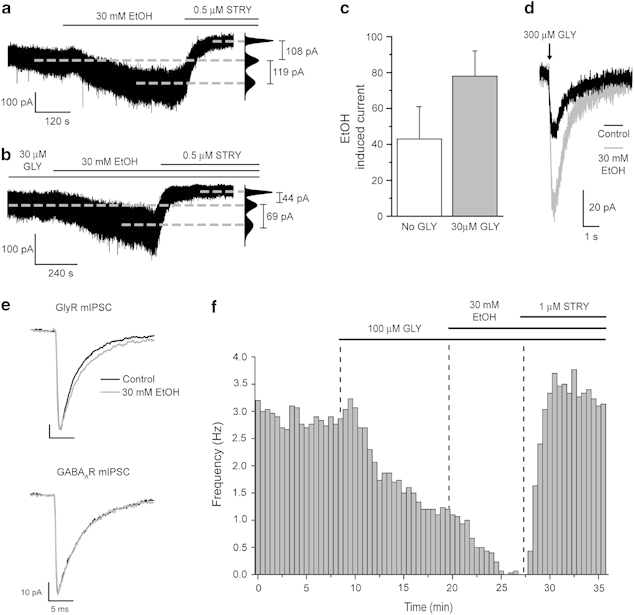Figure 5.

Ethanol enhances the function of DR GlyRs and suppresses neuronal excitability. (a) A representative whole-cell voltage-clamp recording illustrating that ethanol (30 mM)—in the absence of added glycine—produces a large inward current, which is reversed by the subsequent application of strychnine (STRY, 0.5 μM) to beyond baseline (see corresponding all-points histogram on the right of the trace). Thus, ethanol acts to enhance the endogenous glycinergic tonic conductance. (b) A representative whole-cell voltage-clamp recording illustrating that ethanol (30 mM)—in the presence of 30 μM glycine (GLY)—produces a large inward current, which is reversed by strychnine (STRY, 0.5 μM) to beyond baseline (see corresponding all-points histogram on the right). Thus, both the effects of glycine and ethanol are mediated by GlyRs. (c) A bar graph summarizing the current induced by the bath application of 30 mM ethanol in the absence (white) or in the presence of 30 μM glycine (grey) in six and seven DR neurons, respectively. Data are derived from ethanol-sensitive neurons only (six out of nine and seven out of seven in the absence and in the presence of 30 μM glycine, respectively). Note that in the absence of added glycine, the proportion of ethanol-sensitive neurons (67%) was similar to those sensitive to strychnine, ie, exhibiting an endogenous glycinergic conductance. (d) A representative whole-cell voltage-clamp recording of the current induced by the focal application (duration 20 ms, pressure 10 psi) of 300 μM glycine to a DR neuron before and after the bath application of 30 mM ethanol (EtOH). Note that ethanol increases the total charge transfer. (e) Representative normalized (to control peak amplitude) ensemble averages of GlyR- (top traces) and GABAAR-mediated (bottom traces) mIPSCs in control conditions (black) and in the presence of 30 mM ethanol (grey). Note that ethanol prolongs the decay of GlyR-mediated, but not that of GABAAR-mediated, mIPSCs. Labels are the same for calibration bars shown for top and bottom traces. (f) A frequency plot depicting the inhibition of action current discharge by 100 μM glycine (in the presence of 10 μM phenylephrine) obtained from a representative recording of a DR neuron. The plot further demonstrates that ethanol (30 mM) enhances this inhibitory effect of glycine. Note that the subsequent application of strychnine not only reverses the inhibitory effects of glycine and ethanol but also increases the frequency of action current discharge to a level greater than control, thus suggesting the presence of a GlyR-mediated inhibitory tone.
